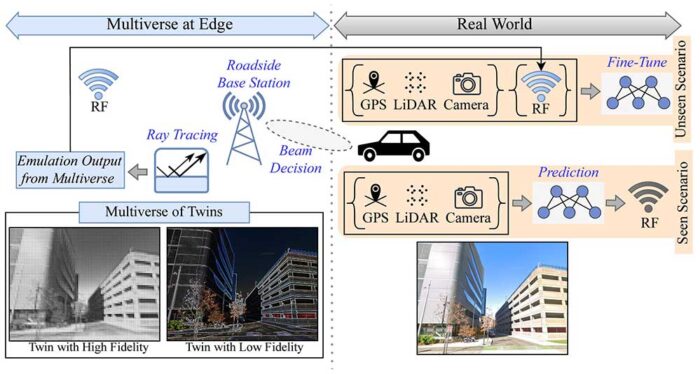Batool Salehi
Ph.D. Student

In the pursuit of creating a digital world that mimics reality, ‘digital twins’ have emerged as powerful tools. This paper focuses on wireless millimeter-wave band radios mounted on vehicles, proposing a revolutionary approach called the ‘Multiverse.’ It involves multiple digital twins working in real-time to optimize directional beam selection in dynamic mobile environments.
A smart decision strategy within the vehicle selects the most suitable twin, considering computational and latency constraints. A self-learning scheme based on Multiverse outcomes enhances decision-making using machine learning over time.
Using a publicly available RF dataset collected from an autonomous car ensures realism:
The Multiverse of digital twins holds immense promise in revolutionizing mobile communication by enabling real-time adaptability and improving directional beam selection. This research brings us closer to more advanced and reliable mobile communication systems.
Creating a digital world that closely mimics the real world with its many complex interactions and outcomes is possible today through advanced emulation software and ubiquitous computing power. Such a software-based emulation of an entity that exists in the real world is called a ‘digital twin’.
In this paper, we consider a twin of a wireless millimeter-wave band radio that is mounted on a vehicle and show how it speeds up directional beam selection in mobile environments. To achieve this, we go beyond instantiating a single twin and propose the ‘Multiverse’ paradigm, with several possible digital twins attempting to capture the real world at different levels of fidelity. Towards this goal, this paper describes (i) a decision strategy at the vehicle that determines which twin must be used given the computational and latency limitations, and (ii) a self-learning scheme that uses the Multiverse-guided beam outcomes to enhance DL-based decision-making in the real world over time.
Our work is distinguished from prior works as follows: First, we use a publicly available RF dataset collected from an autonomous car for creating different twins. Second, we present a framework with continuous interaction between the real world and Multiverse of twins at the edge, as opposed to a one-time emulation that is completed prior to actual deployment. Results reveal that Multiverse offers up to 79.43% and 85.22% top-10 beam selection accuracy for LOS and NLOS scenarios, respectively. Moreover, we observe 52.72-85.07% improvement in beam selection time compared to 802.11ad standard.
Source: arxiv.org
Ph.D. Student
Associate Professor of Electrical and Computer Engineering
Professor of Electrical and Computer Engineering
Institute Associate Director